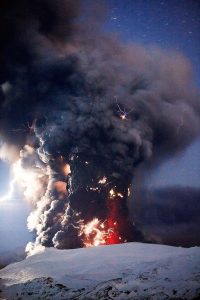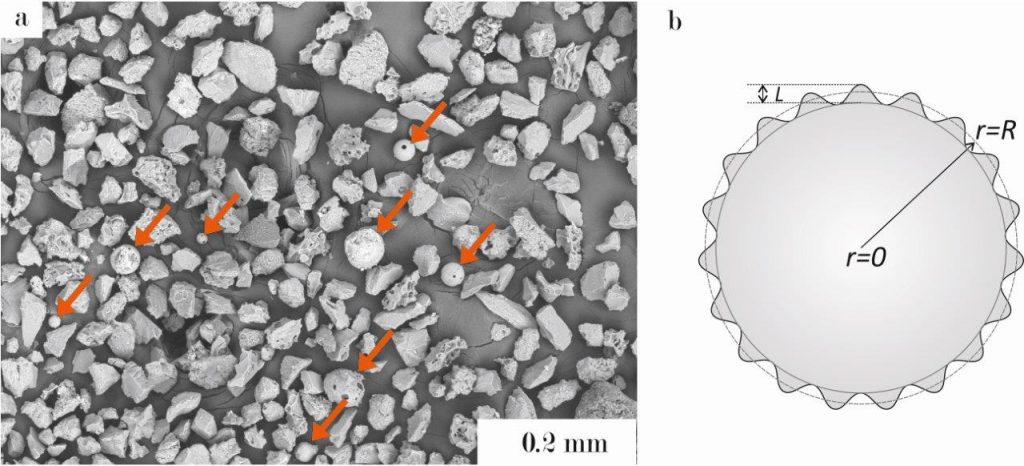27 April 2017
Glass formed by volcanic lightning could be used to study eruptions
Posted by Lauren Lipuma

Volcanic lightning strikes within the plume erupting from Iceland’s Eyjafjallajökull volcano in 2010. Researchers have developed a way to study volcanic lightning from glass spheres that remain after an eruption.
Credit: Wikimedia/Terje Sørgjerd.
By Alexandra Branscombe
Researchers who study volcanoes must get creative: The extreme conditions of an erupting volcano can destroy instruments used to measure the fiery event, making studying the heat, energy, lava flow, and other characteristics of the eruption difficult.
Now, researchers have developed a method to measure one of the most striking and difficult to measure volcanic features – volcanic lightning – using the tiny glass spheres formed by hot volcanic ash.
Volcanic lightning can occur when ash shoots out of a volcano, building up a charge as particles are heated rapidly and rub against each other. When the lightning strikes in the plume, it is hot enough to change ash particles into small glass spheres.
Researchers developed a new model using information from these tiny glass spheres — as small as a dot of ink from a pen — to study the properties of volcanic lightning.
Information about volcanic lightning could help volcanologists better understand volcanic plumes. It could also allow researchers to study volcanic eruptions long after the blast, or in remote places where there is no monitoring equipment, according to a new study detailing the model in the Journal of Geophysical Research: Solid Earth, a publication of the American Geophysical Union.
“Lots of ash gets zapped,” said Fabian Wadsworth, an assistant professor of volcanology at Ludwig Maximilian University of Munich in Germany, and lead author of the new study. “The number of these spheres are quite high in volcanic deposits, especially after very intense eruptions.”
Working backwards
Like detectives following a trail, Wadsworth and his colleagues used the glass spheres to provide data on the volcanic lightning and the eruption.
To do this, the researchers created a numerical model to analyze the diameter of the glass spheres and the melting point of the ash type making up the spheres. The model then evaluates how much heat is needed to transform the ash into a sphere.
Because different kinds of rock melt at different temperatures, each volcano will produce different size spheres. For example, basaltic volcanoes, such as the one on the Italian Island of Stromboli, may be unable to create spheres because the melting point of basalt is so high. If an eruption could generate enough lighting, it would likely produce fewer spheres from small particles.
The researchers tested their model using glass spheres collected from the 2009 eruption of the Redoubt Volcano in Alaska and the 2010 Eyjafjallajökull eruption in Iceland, and laboratory-created spheres.
The model revealed the temperature and duration of the lightning in the ash plume that created the glass spheres, giving the researchers information about the conditions within the volcanic plume at the time of the eruption. The analysis showed that the spheres from both the Redoubt and Eyjafjallajökull eruptions were likely formed from lighting temperatures between approximately 2,700 and 4,700 degrees Celsius (5,000-8,500 degrees Fahrenheit). The heat created glass spheres ranging from one thousandth to four thousandths of a centimeter in diameter at the Redoubt volcano, and spheres smaller than two thousandths of a centimeter after the Eyjafjallajökull eruption.

Glass spheres from the 2009 Redoubt eruption can be seen among ash particles under electron microscopy.
Credit: Wadsworth et al., JGR: Solid Earth/AGU.
The new study also found that the formation of the glass sphere is limited by the rate of heat transfer from the lightning to the center of the ash particle. If the ash is too big, the heat will not reach the center of the particle.
“If [scientists] apply our simple method, they should be able to go to a volcanic deposit, measure the size of the spheres, then work out how hot the lightning discharges were and how long they lasted,” Wadsworth said. “We can work backward to the lightning events.”
Looking forward
Information about volcanic lightning could help scientists understand more about the volcanic plume itself, according to the study’s authors.
Understanding the heat, duration, and frequency of volcanic lighting can help researchers estimate the ash discharge rate, particle size distribution and the vent pressure of a volcano. This information could be useful to scientists studying how volcanic ash melts and reacts to heat, which is important for researching the hazard volcanic ash poses to airplanes. The ash from an erupting volcano can melt inside jet engine turbines and damage airplanes in flight.
“If you want to study a volcano, you have to use a range of tools to get different information. You gather them together and get a better picture of what is going on,” said Jérémie Vasseur, a volcanologist at LMU Munich, and coauthor of the new study. “Monitoring volcanic lightning is another piece of the puzzle.”
This method is also safer and cheaper than deploying conventional monitoring tools, Wadsworth said.
“It is much easier to employ tools for monitoring lightning than to deploy large arrays of more expensive volcano monitoring equipment,” he said.
— Alexandra Branscombe is a freelance science writer. Follow her on twitter at @alibranscombe.


 GeoSpace is a blog on Earth and space science, managed by AGU’s Public Information staff. The blog features posts by AGU writers and guest contributors on all sorts of relevant science topics, but with a focus on new research and geo and space sciences-related stories that are currently in the news.
GeoSpace is a blog on Earth and space science, managed by AGU’s Public Information staff. The blog features posts by AGU writers and guest contributors on all sorts of relevant science topics, but with a focus on new research and geo and space sciences-related stories that are currently in the news.